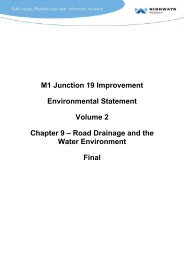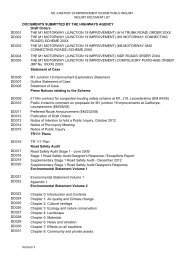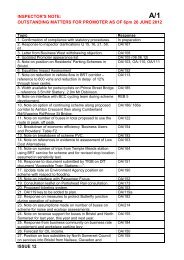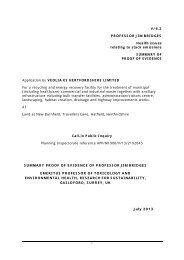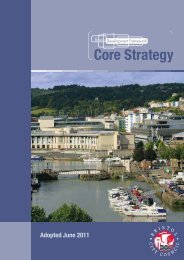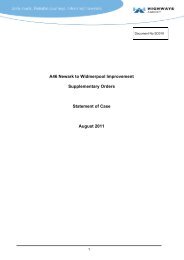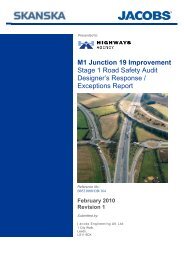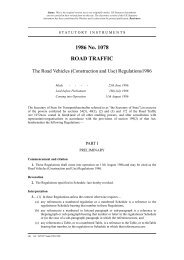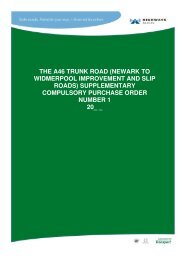Evaluation and Measurement for Vibration in Buildings Part 1, BSI ...
Evaluation and Measurement for Vibration in Buildings Part 1, BSI ...
Evaluation and Measurement for Vibration in Buildings Part 1, BSI ...
Create successful ePaper yourself
Turn your PDF publications into a flip-book with our unique Google optimized e-Paper software.
ISO 4866:1990(E)<br />
Licensed copy:HALCROW GROUP LTD, 27/01/2009, Uncontrolled Copy, © <strong>BSI</strong><br />
9.2 Types of <strong>in</strong>vestigation<br />
For many of the parameters of <strong>in</strong>terest, listed<br />
<strong>in</strong> 9.1 a) to g), the choice of <strong>in</strong>strumentation, its<br />
location with<strong>in</strong> the build<strong>in</strong>g, the type of record<strong>in</strong>g<br />
device <strong>and</strong> the number of data channels or<br />
measurement po<strong>in</strong>ts desired, the duration of<br />
monitor<strong>in</strong>g <strong>for</strong> the phenomena <strong>and</strong> the speed of data<br />
collection will immediately be decided. The<br />
outl<strong>in</strong><strong>in</strong>g of <strong>in</strong>strumentation requirements <strong>in</strong><br />
clause 6 <strong>and</strong> annex C has been arranged <strong>in</strong> such a<br />
way as to facilitate the selection of <strong>in</strong>strumentation<br />
to meet particular requirements. Beyond this it is<br />
important to del<strong>in</strong>eate the degree of sophistication<br />
to be applied to the <strong>in</strong>vestigation. Instruments<br />
which characterize the vibration environment by a<br />
s<strong>in</strong>gle quantity, such as those used <strong>in</strong> connection<br />
with human response <strong>and</strong> mach<strong>in</strong>e condition, may<br />
be used <strong>in</strong> a prelim<strong>in</strong>ary survey so long as the<br />
limited frequency responses are taken <strong>in</strong>to account.<br />
For the purposes of this International St<strong>and</strong>ard, a<br />
prelim<strong>in</strong>ary assessment, a monitor<strong>in</strong>g program, a<br />
field survey <strong>and</strong> a detailed eng<strong>in</strong>eer<strong>in</strong>g analysis are<br />
under consideration.<br />
9.2.1 Prelim<strong>in</strong>ary assessment<br />
Situations may arise where an assessment has to be<br />
made of vibration problems by desk study alone,<br />
usually be<strong>for</strong>e field measurements. Empirical<br />
methods can be used to estimate response provided<br />
that data on the source parameters <strong>and</strong> build<strong>in</strong>g<br />
response characteristics, such as fundamental<br />
frequency <strong>and</strong> damp<strong>in</strong>g, are available.<br />
9.2.2 Exploratory monitor<strong>in</strong>g<br />
Very limited measurement of vibration on a<br />
build<strong>in</strong>g or over an area can <strong>in</strong>dicate the existence<br />
of a problem requir<strong>in</strong>g further <strong>in</strong>vestigation. High<br />
errors are not uncommon <strong>and</strong> this fact has to be kept<br />
<strong>in</strong> m<strong>in</strong>d. (See also f<strong>in</strong>al paragraph <strong>in</strong> 9.2.3.)<br />
9.2.3 Field survey<br />
A field survey would consist of a limited number<br />
(see also 7.1) of vibration measurement locations <strong>in</strong><br />
order to assess the vibration severity often <strong>in</strong><br />
comparison with values stipulated <strong>in</strong> codes or<br />
regulations.<br />
In the case of vibrations which can be reproduced <strong>for</strong><br />
a sufficient time, the same transducers can be used<br />
<strong>for</strong> the different po<strong>in</strong>ts keep<strong>in</strong>g a reference po<strong>in</strong>t at<br />
the foundation level near the source.<br />
As regards exploratory monitor<strong>in</strong>g (see 9.2.2) <strong>and</strong><br />
field surveys, measurements should be of an<br />
accuracy compatible with the uncerta<strong>in</strong>ties implicit<br />
<strong>in</strong> the vibration <strong>in</strong>dices <strong>and</strong> empirical relationship<br />
used. S<strong>in</strong>gle parameter <strong>in</strong>dices, such as peak<br />
particle velocity or peak acceleration <strong>and</strong> r.m.s,<br />
values, need, generally, only to be known to<br />
with<strong>in</strong> ± 10 % at the 68 % confidence level.<br />
9.2.4 Eng<strong>in</strong>eer<strong>in</strong>g analysis<br />
When complex structures of vital importance are<br />
be<strong>in</strong>g subjected to vibration excitation of a<br />
magnitude that requires serious consideration of<br />
the consequences, the structural behaviour needs to<br />
be assessed <strong>in</strong> a more detailed way.<br />
Instrumentation <strong>for</strong> monitor<strong>in</strong>g the time history<br />
should be mounted at a number of locations to<br />
ensure that specific values <strong>for</strong> that structure are not<br />
exceeded.<br />
If the ground-to-foundation transfer function is of<br />
concern, simultaneous record<strong>in</strong>g outside <strong>and</strong> on the<br />
foundation should be carried out. The record<strong>in</strong>g<br />
position on the foundation is at a po<strong>in</strong>t on the ma<strong>in</strong><br />
wall at ground floor level or the basement.<br />
The number of measur<strong>in</strong>g po<strong>in</strong>ts <strong>and</strong> their location<br />
have to be def<strong>in</strong>ed <strong>and</strong> modified accord<strong>in</strong>g to the<br />
characteristics of the build<strong>in</strong>g <strong>and</strong> the observations<br />
noticed dur<strong>in</strong>g monitor<strong>in</strong>g.<br />
The natural frequencies of build<strong>in</strong>gs should be<br />
determ<strong>in</strong>ed, if possible.<br />
In the case of vibrations which can be reproduced <strong>for</strong><br />
a sufficient time, the same transducers can be used<br />
<strong>for</strong> the different po<strong>in</strong>ts keep<strong>in</strong>g a reference po<strong>in</strong>t at<br />
the foundation level near the source.<br />
For structures of vital importance, response<br />
analysis should be carried out as well as an estimate<br />
of structure load<strong>in</strong>g. A full eng<strong>in</strong>eer<strong>in</strong>g analysis<br />
requires a system which would enable frequency to<br />
be estimated to ± 1 % <strong>and</strong> damp<strong>in</strong>g to ± 10 %.<br />
9.3 Report<strong>in</strong>g of control activities<br />
The style of report<strong>in</strong>g should be consistent with the<br />
type of <strong>in</strong>vestigation (see 9.2), but as a m<strong>in</strong>imum the<br />
report should <strong>in</strong>clude the follow<strong>in</strong>g:<br />
a) Risk analysis<br />
1) Description of the source.<br />
2) Type <strong>and</strong> condition of build<strong>in</strong>g, <strong>in</strong><br />
accordance with annex A.<br />
3) Purpose of the measurement.<br />
4) Reference to the st<strong>and</strong>ard be<strong>in</strong>g used <strong>and</strong><br />
type of <strong>in</strong>vestigation.<br />
b) <strong>Measurement</strong>s<br />
1) Position of transducer <strong>and</strong> manner of<br />
coupl<strong>in</strong>g.<br />
2) Type <strong>and</strong> make of transducer, signal<br />
condition<strong>in</strong>g <strong>and</strong> record<strong>in</strong>g equipment.<br />
3) Calibration factors <strong>for</strong> the <strong>in</strong>strumentation<br />
system.<br />
4) Frequency range <strong>and</strong> l<strong>in</strong>earity.<br />
5) Assessment of the sources of error.<br />
© <strong>BSI</strong> 01-1999 9



